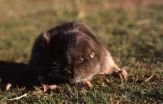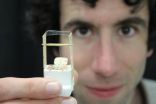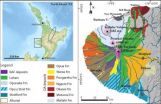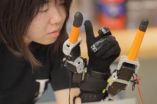(Press-News.org) (SACRAMENTO, Calif.) – Researchers from UC Davis School of Medicine and Shriners Hospitals for Children – Northern California have identified a group of cells in the brain that they say plays an important role in the abnormal neuron development in Down syndrome. After developing a new model for studying the syndrome using patient-derived stem cells, the scientists also found that applying an inexpensive antibiotic to the cells appears to correct many abnormalities in the interaction between the cells and developing neurons.
The findings, which focused on support cells in the brain called astroglial cells, appear online today in Nature Communications.
"We have developed a human cellular model for studying brain development in Down syndrome that allows us to carry out detailed physiological studies and screen possible new therapies," said Wenbin Deng, associate professor of biochemistry and molecular medicine and principal investigator of the study. "This model is more realistic than traditional animal models because it is derived from a patient's own cells."
Down syndrome is the most common chromosomal cause of mild to moderate intellectual disabilities in the United States, where it occurs in one in every 691 live births. It develops when a person has three copies of the 21st chromosome instead of the normal two. While mouse models have traditionally been used in studying the genetic disorder, Deng said the animal model is inadequate because the human brain is more complicated, and much of that complexity arises from astroglia cells, the star-shaped cells that play an important role in the physical structure of the brain as well as in the transmission of nerve impulses.
"Although neurons are regarded as our 'thinking cells,' the astroglia have an extremely important supportive role," said Deng. "Astroglial function is increasingly recognized as a critical factor in neuronal dysfunction in the brain, and this is the first study to show its importance in Down syndrome."
Creating a unique human cellular model
To investigate the role of astroglia in Down syndrome, the research team took skin cells from individuals with Down syndrome and transformed them into stem cells, which are known as induced pluripotent stem cells (iPSC). The cells possess the same genetic make-up as the donor and an ability to grow into different cell types. Deng and his colleagues next induced the stem cells to develop into separate pure populations of astroglial cells and neurons. This allowed them to systematically analyze factors expressed by the astroglia and then study their effects on neuron development.
They found that a certain protein, known as S100B, is markedly increased in astroglial cells from patients with Down syndrome compared with those from healthy controls. S100B released by astroglial cells promotes harmful astroglial activation (astrogliosis) and adversely affects neurons, causing them to die at increased rates or develop in multiple dysfunctional ways.
The investigators obtained further evidence of the critical role of astroglial cells in Down syndrome by implanting the skin-cell derived astroglial cells from Down syndrome patients into mice. Those mice then developed the neuropathological phenotypes of Down syndrome, while mice implanted with Down syndrome neurons did not.
Neuroprotective effects of antibiotics
The research team also screened candidate drugs using a 'disease-in-a-dish' model. When they administered minocycline — a tetracycline antibiotic with anti-inflammatory properties commonly used to treat bacterial infections, acne and arthritis — many of the abnormalities in the astroglial cells were corrected and there were more healthy interactions between the astroglia and neurons compared to the control cells without the defect.
"The advent of induced pluripotent stem cell technology has created exciting new approaches to model neurodevelopmental and neurodegenerative diseases for the study of pathogenesis and for drug screening," said David Pleasure, professor of neurology and pediatrics and a co-author of the study. "Using this technology, the study is the first to discover the critical role of astroglial cells in Down syndrome as well as identify a promising pathway for exploring how a drug such as minocycline may offer an effective way to help treat it."
Pleasure, who is research director at Shriner's Hospital for Children Northern California and also directs the Institute for Pediatric Regenerative Medicine, noted that considerable research interest has arisen about the use of minocycline for diseases of the central nervous system because of the increasing evidence about its neuroprotective effects. Unlike many drugs, minocycline can cross from the bloodstream into the brain so that it can act on the astroglial cells. The drug has never been tested as a treatment for Down syndrome, and both Pleasure and Deng cautioned that its safety and efficacy will require clinical trials in people with Down syndrome.
Currently, Deng's laboratory is conducting additional preclinical studies using the human-derived stem cells from Down syndrome patients and mouse models to determine whether cellular and behavioral abnormalities can be improved with minocycline therapy and other candidate drugs.
"The abnormalities we identified occur in the early stages of Down syndrome," said Deng. "While much more research is needed, it is exciting to consider that pharmacological intervention in these cellular processes might help slow or even prevent disease progression."
INFORMATION:
Co-lead authors of the article, titled "Role of astroglia in Down's syndrome revealed by patient-derived human-induced pluripotent stem cells," were Chen Chen and Peng Jiang, both of the UC Davis Department of Biochemistry and Molecular Medicine and the Institute for Pediatric Regenerative Medicine (a collaboration between UC Davis and Shriners Hospitals for Children Northern California); Deng and Ying Liu of the Center for Stem Cell and Regenerative Medicine at the University of Texas Health Science Center co-directed the study. Other authors were Suzanne Peterson, Ha Tran, Anna McCann, Louise Laurent and Jeanne Loring of the Center for Regenerative Medicine at The Scripps Research Institute; Mana Parast of UC San Diego; and Haipeng Xue and Shenlan Li of the Center for Stem Cell and Regenerative Medicine at the University of Texas Health Science Center.
The work was supported by the National Institutes of Health (R01NS061983, R01ES015988, R21 MH087925), the National Institutes of Health/National Institute of Child Health and Human Development Career Development Award (K12 HD001259), the National Multiple Sclerosis Society, Shriners Hospitals for Children, the California Institute for Regenerative Medicine (RT1-011071, RT1-01108, TR1-01250, CL1-00502), the Memorial Hermann Foundation (Staman Ogilvie Fund), the Bentsen Stroke Center, the Esther O'Keeffe Foundation, and the Hartwell Foundation.
'Support' cells in brain play important role in Down syndrome
New research also suggests common antibiotic might help treat the genetic defect
2014-07-18
ELSE PRESS RELEASES FROM THIS DATE:
Four new species of tuco-tucos identified from Bolivia
2014-07-18
Lincoln, Neb., July 18, 2014 -- A research team led by Scott Gardner of the University of Nebraska-Lincoln has identified four new species of Ctenomys, a genus of gopher-like mammal found throughout much of South America.
Commonly called tuco-tucos, the burrowing rodents range from 7 to 12 inches long and weigh less than a pound. They demonstrate the broad range of biological diversity in the lowlands and central valleys of Bolivia, where all four new species were found, Gardner said.
It is very rare to identify a new species of mammal, said Gardner, director of the H.W. ...
New material puts a twist in light
2014-07-18
Scientists at The Australian National University (ANU) have uncovered the secret to twisting light at will. It is the latest step in the development of photonics, the faster, more compact and less carbon-hungry successor to electronics.
A random find in the washing basket led the team to create the latest in a new breed of materials known as metamaterials. These artificial materials show extraordinary properties quite unlike natural materials.
"Our material can put a twist into light – that is, rotate its polarisation – orders of magnitude more strongly than natural materials," ...
In alcohol abusers, fish oil may reduce risk of neurodegeneration and ensuing dementia
2014-07-18
MAYWOOD, Ill-- Omega-3 fish oil might help protect against alcohol-related neurodamage and the risk of eventual dementia, according to a study published in the journal PLOS ONE.
Many human studies have shown that long-term alcohol abuse causes brain damage and increases the risk of dementia. The new study found that in brain cells exposed to high levels of alcohol, a fish oil compound protected against inflammation and neuronal cell death.
The study was conducted by Michael A. Collins, PhD, Edward J. Neafsey, PhD, and colleagues at Loyola University Chicago Stritch ...
Weight management program also reduces depression among black women
2014-07-18
DURHAM, N.C. -- An intervention program aimed at helping obese women maintain their weight without adding pounds also significantly reduced depression in nearly half the participants, according to a new study from Duke University.
The study was conducted with 185 low-income black women ages 25-44, each with a body mass index (BMI) of 25 to 35, who were receiving primary care at five community health centers in central North Carolina.
The program used software built by Duke researchers that personalized a weight-gain prevention intervention called the Shape Program for ...
Catastrophic debris avalanches -- a second volcanic hazard
2014-07-18
Boulder, Colo., USA – Volcanic hazards aren't limited to eruptions. Debris avalanche landslides can also cause a great deal of damage and loss of life. Stratovolcanoes, with their steep, conical shapes made up of lava and unconsolidated mixed materials, can reach a critical point of instability when they overgrow their flanks. This leads to partial collapse, and the product of this slope failure is a large-scale, rapid mass movement known as a catastrophic landslide or debris avalanche.
In a matter of minutes, a debris avalanche can drastically modify the shape and nature ...
Bowel cancer breakthrough may benefit thousands of patients
2014-07-18
Researchers at Queen's University have made a significant breakthrough that may benefit patients with bowel cancer.
Dr Sandra van Schaeybroeck and her team have discovered how two genes cause bowel cancer cells to become resistant to treatments used against the disease. The research, which was funded by Cancer Research UK, was published this month in the prestigious international journal Cell Reports.
The activity of the two genes, called MEK and MET, was uncovered when the researchers looked at all the different pathways and interactions taking place in bowel cancer ...
Scientists enlist big data to guide conservation efforts
2014-07-18
Despite a deluge of new information about the diversity and distribution of plants and animals around the globe, "big data" has yet to make a mark on conservation efforts to preserve the planet's biodiversity. But that may soon change.
A new model developed by University of California, Berkeley, biologist Brent Mishler and his colleagues in Australia leverages this growing mass of data – much of it from newly digitized museum collections – to help pinpoint the best areas to set aside as preserves and to help biologists understand the evolutionary history of life on Earth. ...
A new measure of biodiversity
2014-07-18
A new approach to measuring biodiversity has uncovered some biologically important but currently unprotected areas in Western Australia, while confirming the significance of the world heritage listed Wet Tropics rainforests in the country's north-east.
In a paper published yesterday (Friday 18 July) in Nature Communications, scientists from CSIRO, University of California, University of Canberra, the Australian Tropical Herbarium at James Cook University and University of New South Wales applied the new method to Australia's iconic Acacia.
The genus Acacia includes ...
Getting a grip on robotic grasp
2014-07-18
CAMBRIDGE, MA -- Twisting a screwdriver, removing a bottle cap, and peeling a banana are just a few simple tasks that are tricky to pull off single-handedly. Now a new wrist-mounted robot can provide a helping hand — or rather, fingers.
Researchers at MIT have developed a robot that enhances the grasping motion of the human hand. The device, worn around one's wrist, works essentially like two extra fingers adjacent to the pinky and thumb. A novel control algorithm enables it to move in sync with the wearer's fingers to grasp objects of various shapes and sizes. Wearing ...
Biomarker discovery may lead to new HIV treatment
2014-07-18
Further analysis of a Phase II study of therapeutic HIV vaccine candidate Vacc-4x revealed a potential biomarker associated with participants who experienced a more profound viral load reduction after receiving the vaccine. The results of this exploratory, ad hoc, subset analysis by St George's, University of London and Bionor Pharma were announced today at the AIDS 2014 Conference in Melbourne, Australia.
If confirmed, the biomarker may be able to predict which patients will benefit most from the therapeutic HIV vaccine candidate Vacc-4x, which is being developed by ...
LAST 30 PRESS RELEASES:
Decoupling the HOR enhancement on PtRu: Dynamically matching interfacial water to reaction coordinates
Sulfur isn’t poisonous when it synergistically acts with phosphine in olefins hydroformylation
URI researchers uncover molecular mechanisms behind speciation in corals
Chitin based carbon aerogel offers a cleaner way to store thermal energy
Tracing hidden sources of nitrate pollution in rapidly changing rural urban landscapes
Viruses on plastic pollution may quietly accelerate the spread of antibiotic resistance
Three UH Rainbow Babies & Children’s faculty elected to prestigious American Pediatric Society
Tunnel resilience models unveiled to aid post-earthquake recovery
Satellite communication systems: the future of 5G/6G connectivity
Space computing power networks: a new frontier for satellite technologies
Experiments advance potential of protein that makes hydrogen sulfide as a therapeutic target for Alzheimer’s disease
Examining private equity’s role in fertility care
Current Molecular Pharmacology achieves a landmark: real-time CiteScore advances to 7.2
Skeletal muscle epigenetic clocks developed using postmortem tissue from an Asian population
Estimating unemployment rates with social media data
Climate policies can backfire by eroding “green” values, study finds
Too much screen time too soon? A*STAR study links infant screen exposure to brain changes and teen anxiety
Global psychiatry mourns Professor Dan Stein, visionary who transformed mental health science across Africa and beyond
KIST develops eco-friendly palladium recovery technology to safeguard resource security
Statins significantly reduce mortality risk for adults with diabetes, regardless of cardiovascular risk
Brain immune cells may drive more damage in females than males with Alzheimer’s
Evidence-based recommendations empower clinicians to manage epilepsy in pregnancy
Fungus turns bark beetles’ defenses against them
There are new antivirals being tested for herpesviruses. Scientists now know how they work
CDI scientist, colleagues author review of global burden of fungus Candida auris
How does stroke influence speech comprehension?
B cells transiently unlock their plasticity, risking lymphoma development
Advanced AI dodel predicts spoken language outcomes in deaf children after cochlear implants
Multimodal imaging-based cerebral blood flow prediction model development in simulated microgravity
Accelerated streaming subgraph matching framework is faster, more robust, and scalable
[Press-News.org] 'Support' cells in brain play important role in Down syndromeNew research also suggests common antibiotic might help treat the genetic defect




